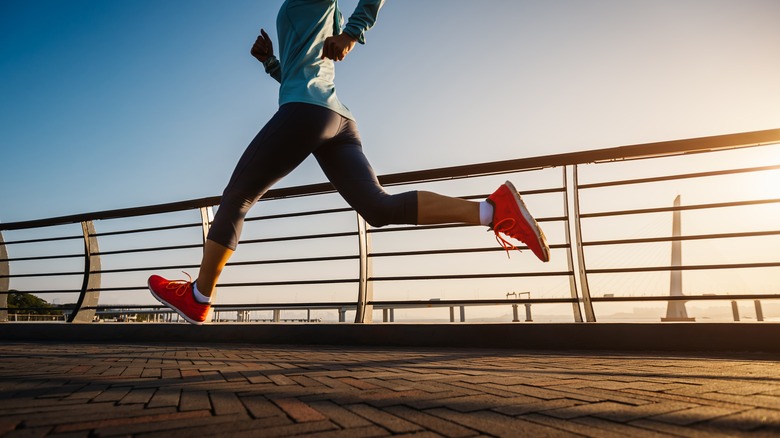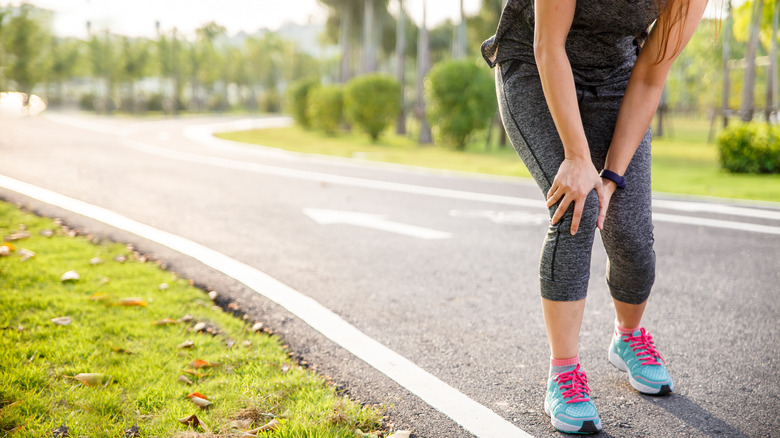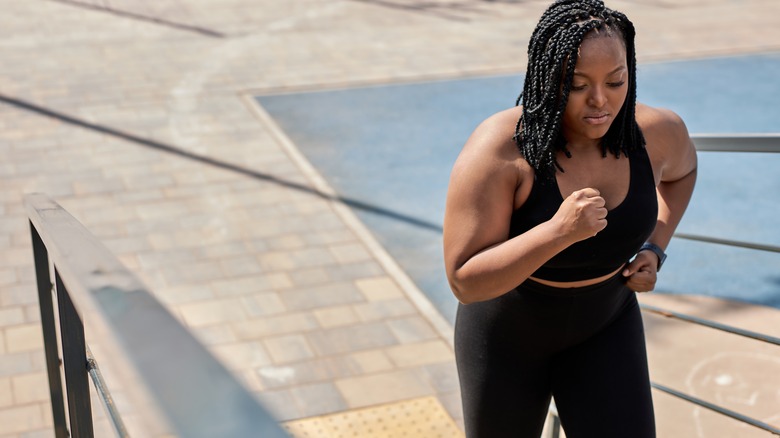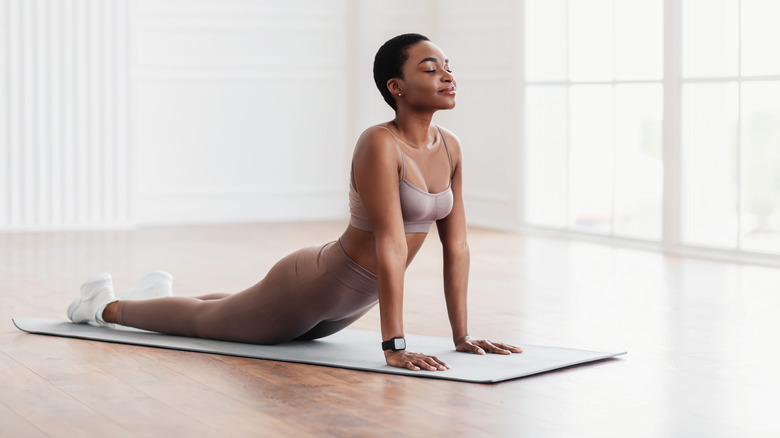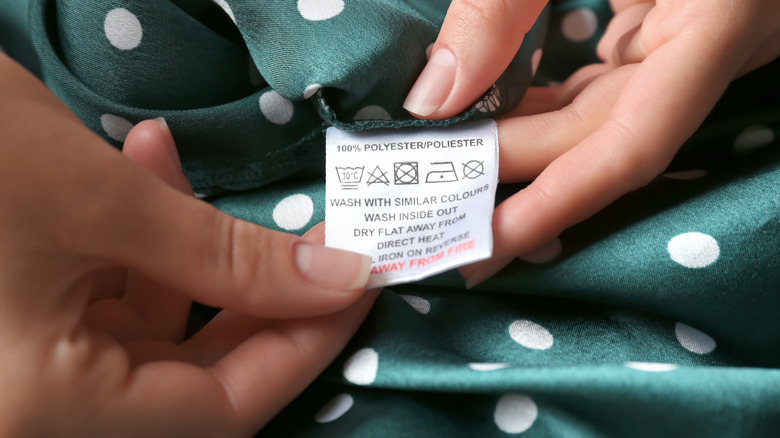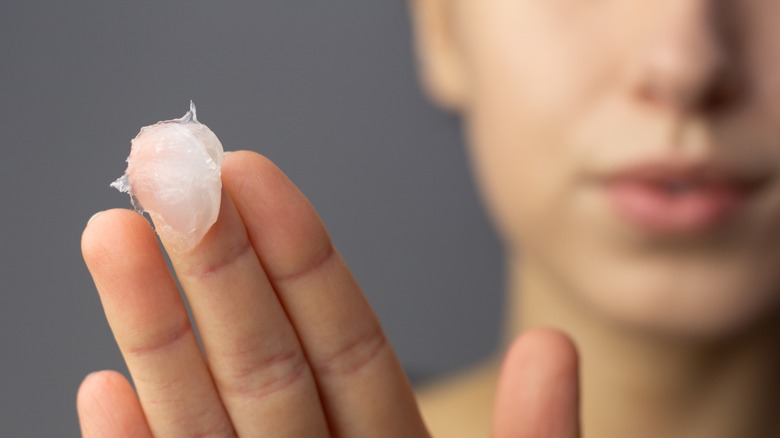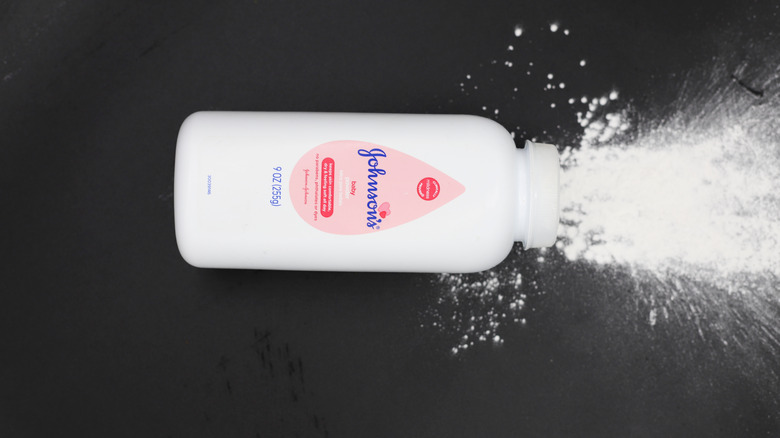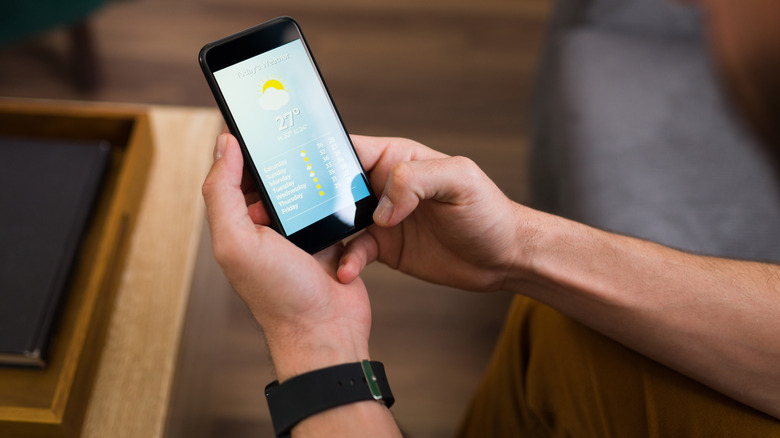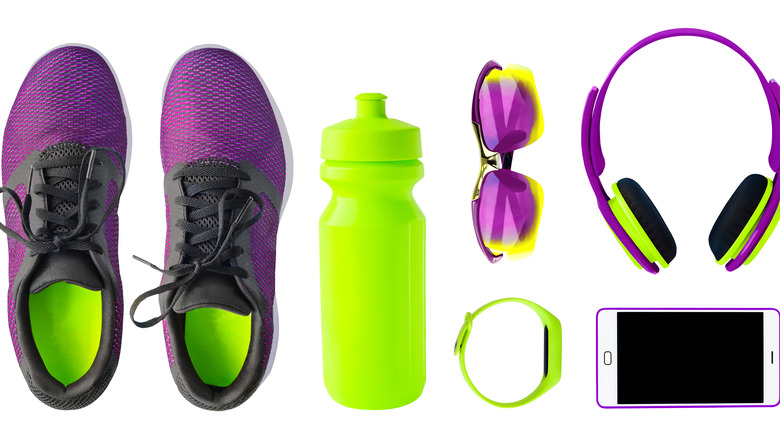9 Ways To Prevent Chafing While Running
If you're a runner, it's very likely you've experienced chafing at some point. This pesky, painful condition is not only incredibly irritating, but it can also leave you down for the count for a few days. This is frustrating when you're trying to reach certain goals, like training for a marathon.
Chafing can (and usually will) happen to most of us at some point. The secret lies in figuring out how to prevent it. Chafing is primarily caused when you're performing a repetitive movement (like running) where your skin rubs against itself or your clothing (via Medical News Today). It's incredibly common among runners — a small 2014 study published in the Official Publication of the Brazilian Society of Dermatology found that runners reported chafing to be the second most common issue they deal with after blisters. Forty-two percent of runners that took part in the study reported suffering from chafing.
If you've ever had to deal with chafing as a new runner, you know just how demotivating it can be. The fear of dealing with this painful condition again in the future can be enough to put you off running for good. That doesn't need to be the case, however. These days, there are plenty of products you can use to help you prevent chafing from occurring altogether, and modern activewear is also being designed to ensure comfort. If you're ready to make your next run 100% chafe-free, read on for our best tips on how you can prevent this painful condition.
Signs you're suffering from chafing
Chafing doesn't only occur between the thighs — other areas like your armpits, breasts, nipples, groin, butt, and feet can all suffer from this condition, according to Cleveland Clinic. Telltale signs that an area on your body is chafed are when you experience sore skin that's accompanied by a red and bumpy rash. Your skin might also look dry and flaky. You might also notice skin irritation and itchiness, or feel as if the area stings or burns. It's also not uncommon for the area to be hot to the touch.
Some cases of chafing can be more severe, however, and you might experience muscle pain in addition to the above-mentioned symptoms. Other more severe symptoms include swelling in the chafed area, cracked skin, sores or blisters, welts, and even bleeding. It's also possible that you might get secondary skin infections. These symptoms typically only develop when the chafing is not addressed and/or you do not cease the actions causing it.
Wearing the right clothing can help prevent chafing
One of the best ways to prevent chafing is to pay attention to how your running gear fits. Loose-fitting clothing might be great when you're working at the office all day, but it's definitely not the right choice when you go out for a run. Speaking to Marathon Handbook, dermatologist Dendy Engelman notes that skin-tight clothing is best for running — it creates a barrier so your skin doesn't rub against itself, while also being tight enough so that the fabric doesn't irritate the skin. "Forego loose, ill-fitting cotton clothing because that just traps in moisture," Engelman says, adding that you should ensure your leggings as well as sports bras and tops fit tightly. If you're someone who loves to go running in shorts, you can opt for the Bandelette thigh band to keep thigh chafing from occurring. Runners have been very satisfied with this product, and it's easy to wear, according to Prevention.
Chafing can be prevented by staying hydrated
It's imperative you stay hydrated while running, but did you know that staying on top of your water intake can also play a big role in preventing chafing? "Staying hydrated minimizes the salt concentration in the skin," dermatologist Dendy Engelman told Prevention. She went on to explain that neglecting hydration means your body's sweat production declines, which, in turn, means that it can't wash away the salt crystals that develop on your skin. This causes those tiny crystals to stick around, and eventually, you basically have sandpaper-like skin. Add in some friction, and you have a chafing nightmare on your hands.
Heading out with enough water to keep you hydrated for the duration of your run can be tricky, especially if you're going a long distance. However, there are some excellent water bottles on the market that can make staying hydrated a breeze. The Nathan QuickSqueeze 12 oz. Insulated Handheld bottle, for example, is great for those who run shorter distances where holding onto a bottle won't be a pain. "I do really like this handheld — super light even with a full bottle and my hand doesn't get tired," one happy customer says.
If you run longer distances, consider a bottle that's grip-free, like the Nathan SpeedDraw Plus Insulated Flask. According to Runner's World, this nifty bottle has great extra storage space, thanks to its pouch that is big, yet functional. The adjustable hand strap and easy-to-grip texture mean you'll barely notice you're carrying it on your run.
Opting for a different workout between runs can keep chafing from becoming worse
What makes chafing so frustrating to deal with is the fact that it usually means you have to stop running for a few days. But many of us are stubborn and convince ourselves that we'll be fine, only to end up regretting it when the symptoms worsen.
Dermatologist Kenneth Howe suggests you stop your workout or run as soon as you notice that familiar burn that accompanies chafing. "Don't work out or don't do the exercise that led to it for a while," he told Men's Health, adding that it's vital you give your body time to recover. Pushing through a long run while you're aware of chafing occurring is only going to make it worse. Howe says to clean the chafed area ASAP and dry it properly before administering any other treatment.
In the meantime, you can still opt for other workouts that won't irritate the chafed area (per Prevention). If you have chafing in your thigh area, opt for an upper-body workout (or vice versa). Ensuring you don't create additional friction in that area will help it heal faster, which means you can get back to your regular running schedule ASAP.
Pay attention to the fabric of your clothes
The clothes you wear while running are super important when it comes to preventing chafing, and it's vital you read the labels before buying. The wrong material can be a dealbreaker even if the fit is right. According to Healthline, the best fabrics for preventing chafing are bamboo, nylon, and polyester (the recycled versions of these fabrics work fine too). These fabrics work to wick sweat away from the skin, leaving you dry and comfortable during your runs.
The type of fabric you should opt for will depend on a few factors, like the seasons, whether you're running outside or inside on the treadmill, and the weather conditions you're running in, according to CNET. A great all-rounder is polyester — it works hard whether you're running or doing some yoga, and it holds up well in all types of weather. The fact that it's breathable and very lightweight makes it a great fabric for running. It also helps to keep you warm if you're running in colder weather. However, polyester does have a tendency to hold on to bacteria and fungi, so make sure you wash polyester clothing after each run.
Nylon works in the same way as polyester and also holds up in any type of weather. A sweet extra is that it's also resistant to mildew. If you want to opt for bamboo, you won't be sorry. It has all the benefits of nylon and polyester while also being super soft and odor-resistant — though it can be a lot pricier than other options.
Seamless = chafe-free
When you go out to buy running clothes, make sure you're not in a hurry. By now, you've probably realized that buying running gear requires reading labels and inspecting clothes to ensure they won't cause chafing. According to Healthline, there's one more thing you need to look out for aside from fabric and fit: seams. While you might not even give seams a second thought, they'll quickly make their power known when you're on a long run and you start to feel the burn.
When your workout clothes have seams on the inside, they can easily start to rub against your skin as you start to sweat. So, when you buy running clothes, check the seams first. Seamless options are your best bet, as are flatlock seams. The latter are designed to lie flat rather than sticking out, which means they won't be able to rub against your skin and cause chafing. Something else you can do to ensure comfort while running is to cut off tags when you buy new clothes. While it's unlikely that tags will cause chafing, they can feel scratchy or even cause itchiness during a run, which is the last thing you need when you're in the middle of a marathon.
Lubricate and create a protective barrier over your skin
You might not be aware of this, but dry skin is more prone to chafing than skin that's moisturized, according to Asics. So to ensure your skin stays happy during your run, take some time to prepare beforehand and apply a moisturizer or even petroleum jelly prior to getting dressed. Pay special attention to areas that are prone to chafing, like your groin, nipples, armpits, and thighs. This will help prevent friction and ensure a comfortable, chafe-free run. Speaking to Men's Health, dermatologist Kenneth Howe warns that while lubricants like petroleum jelly and oils work great to prevent chafing, they tend to wear off as you run. This means touch-ups might be necessary, so keeping a small tube of petroleum jelly with you on your run is advisable.
Something else you can try is Body Glide, certified run coach Elizabeth Corkum says. She told Women's Health that applying it under your arms and between your thighs can work wonders to prevent chafing. "It may not be necessary for every run, but probably long runs, or ones in wet or damp conditions," she explains, adding, "You can also use [it] after a run, before getting in the shower to help protect skin from the water."
Try some powders
If you're looking for something that will prevent chafing and last longer than lube, you can opt for powders (via GQ). Not only can they help prevent body odor, but they also do a great job of absorbing any excess moisture and sweat, making them chafe-fighting champions.
If you're wearing shorts during your run and don't want powder to sprinkle everywhere, you can opt for powder-based creams. These nifty chafe-fighters will form an almost chalk-like layer, effectively preventing chafing. It's also easier to apply evenly over your skin than powder. Medicated powders can also work great to treat chafed areas post-run. "After your run, dry the area thoroughly and use a medicated powder to keep the chafed area dry," New York Road Runners coach Melanie Kann told Marathon Handbook.
If you're skeptical about using powder because you've heard some concerning reports about talcum powder possibly being carcinogenic, you'll be happy to hear that alternatives are available (per GQ). There are powders out there made from substances like cornstarch and tapioca, which are considered safe. They work just as well, and you'll have some extra peace of mind.
Pay attention to the weather before going on a run
Have you ever noticed that chafing seems to creep up on you during the hotter months? That's because heat and humidity create the perfect conditions for chafing to occur. Healthline advises you put your weather app to good use and check the temperatures and humidity before you go for a run outside. Any temperature above 98.6 degrees Fahrenheit paired with humidity higher than 70% can contribute to chafing problems, and you're also putting yourself at risk for other scary conditions like heat stroke. Under these conditions, you're better off running indoors on the treadmill in an air-conditioned room than braving the outdoors when it's that hot and humid. If you really love your outdoor runs, consider switching up your routine so you can go running very early in the morning or later in the evening when temperatures are not as high.
Make sure your running accessories fit properly
Nothing can cause chafing quite like running equipment that doesn't fit properly. These days, runners have more extra gear than ever: Heart rate monitors, armbands for storage, and hydration belts and packs are must-haves during a run. But if any of those nifty gadgets have straps that don't fit well or are too loose, you're likely going to feel the burn after your run (via Marathon Handbook).
To prevent your extra gadgets from giving you the worst chafing of your life, Asics suggest you make sure you tighten the straps properly so there's no way for them to rub or bounce against the skin while you're on the move. While tightening straps is a great preventative measure, it also won't hurt to treat the areas of your skin these gadgets are attached to with some form of lube, the same way you do your legs and armpits. Apply some petroleum jelly to areas you know your gadgets will be touching throughout your run to be 100% safe.
How to treat chafing
Sometimes, despite your best efforts, some chafing might still occur. In case that happens, we've got some tips for how you can treat the chafed area so you can continue with your regular running schedule as soon as possible.
The first thing you need to do once you realize you have chafing is to clean the area using water and gentle soap, according to the Cleveland Clinic. You can then moisturize the area using an aloe vera gel. This product not only helps with the pain and discomfort, but it can also prevent the area from becoming infected. You can apply a layer of petroleum jelly after you applied the gel to form a protective layer over your skin. This will help prevent additional irritation to the area. You should also pay attention to the clothes you wear while the chafed area heals. Medical News Today recommends you avoid loose-fitting clothes that can irritate the area further and opt for fitted clothing instead. If the chafing occurred in your groin area, apply some cornstarch to prevent further damage to the skin (per the Cleveland Clinic).
Signs you should see a doctor
In some cases, chafing symptoms might become so severe that you need medical treatment. This typically happens when people continue doing the exercise that caused the irritation in the first place. The skin doesn't get a chance to heal, and symptoms of chafing will continue to get worse.
According to the Cleveland Clinic, some complications can arise if chafing isn't treated properly. For one, you can get nasty infections. Because chafing damages the skin, it can progress to open wounds if you don't give the area a break. Open wounds create the perfect opportunity for bacteria to enter your body and cause infections. You might also eventually develop friction burns. This is nasty — a friction burn means that your skin has practically been scraped off, leaving you vulnerable to infections. Another complication of chafing is intertrigo, a type of dermatitis that usually develops between skin folds and can lead to an oozing rash. This condition is more severe than chafing and typically leads to other complications like bacterial and yeast infections. If you experience any of these conditions, it's vital you make an appointment with your doctor.
If you're treating chafing as you should but start to experience symptoms like crusty skin or discoloration, it's time to give your doctor a call. They will prescribe an antifungal or antibiotic medication that will help clear up symptoms.

